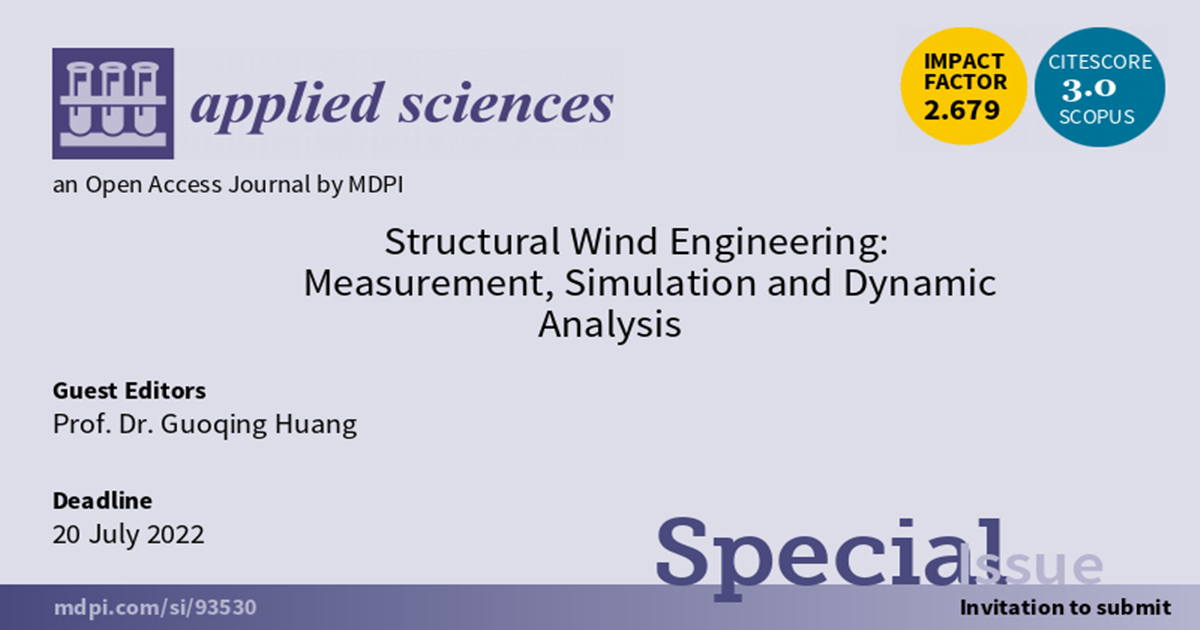Structural Wind Engineering: Measurement, Simulation and Dynamic Analysis
A special issue of Applied Sciences (ISSN 2076-3417). This special issue belongs to the section "Civil Engineering".
Deadline for manuscript submissions: closed (20 July 2022) | Viewed by 13104

Special Issue Editors
Interests: wind resistance of tall buildings; dynamic analysis of wind turbines; random vibration; wind disaster analysis; wind resource assessment and wake analysis; CFD simulation
Interests: computational wind engineering; structural health monitoring; structural vibration
Special Issues, Collections and Topics in MDPI journals
Special Issue Information
Dear Colleagues,
With the rapid development of advanced material and construction technology, the new generation of buildings and other structures commonly feature large flexibility, light mass, and a low damping ratio, thereby making them typically wind-sensitive. In this regard, the innovations of structural wind engineering are required for the wind-resistant design of buildings and other structures under these strong wind events.
In this Special Issue, we invite the publication of original research and review papers in the following areas, but not limited to them:
- Wind tunnel tests;
- Full-scale measurements;
- Computational fluid dynamics (CFD)-based simulations;
- Wind-induced dynamic analyses for buildings and other structures;
- Design standards.
Prof. Dr. Guoqing Huang
Dr. Bowen Yan
Dr. Liuliu Peng
Guest Editors
Manuscript Submission Information
Manuscripts should be submitted online at www.mdpi.com by registering and logging in to this website. Once you are registered, click here to go to the submission form. Manuscripts can be submitted until the deadline. All submissions that pass pre-check are peer-reviewed. Accepted papers will be published continuously in the journal (as soon as accepted) and will be listed together on the special issue website. Research articles, review articles as well as short communications are invited. For planned papers, a title and short abstract (about 100 words) can be sent to the Editorial Office for announcement on this website.
Submitted manuscripts should not have been published previously, nor be under consideration for publication elsewhere (except conference proceedings papers). All manuscripts are thoroughly refereed through a single-blind peer-review process. A guide for authors and other relevant information for submission of manuscripts is available on the Instructions for Authors page. Applied Sciences is an international peer-reviewed open access semimonthly journal published by MDPI.
Please visit the Instructions for Authors page before submitting a manuscript. The Article Processing Charge (APC) for publication in this open access journal is 2400 CHF (Swiss Francs). Submitted papers should be well formatted and use good English. Authors may use MDPI's English editing service prior to publication or during author revisions.
Keywords
- wind tunnel tests
- experiments
- buildings
- non-synoptic wind
Benefits of Publishing in a Special Issue
- Ease of navigation: Grouping papers by topic helps scholars navigate broad scope journals more efficiently.
- Greater discoverability: Special Issues support the reach and impact of scientific research. Articles in Special Issues are more discoverable and cited more frequently.
- Expansion of research network: Special Issues facilitate connections among authors, fostering scientific collaborations.
- External promotion: Articles in Special Issues are often promoted through the journal's social media, increasing their visibility.
- e-Book format: Special Issues with more than 10 articles can be published as dedicated e-books, ensuring wide and rapid dissemination.
Further information on MDPI's Special Issue polices can be found here.







